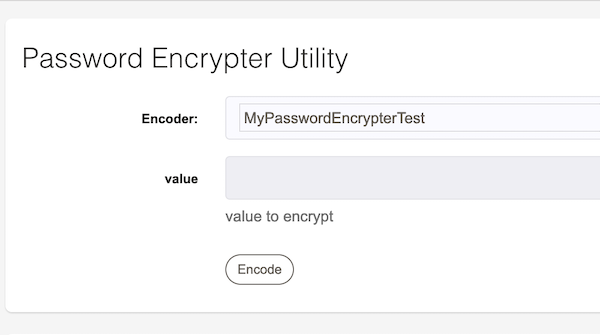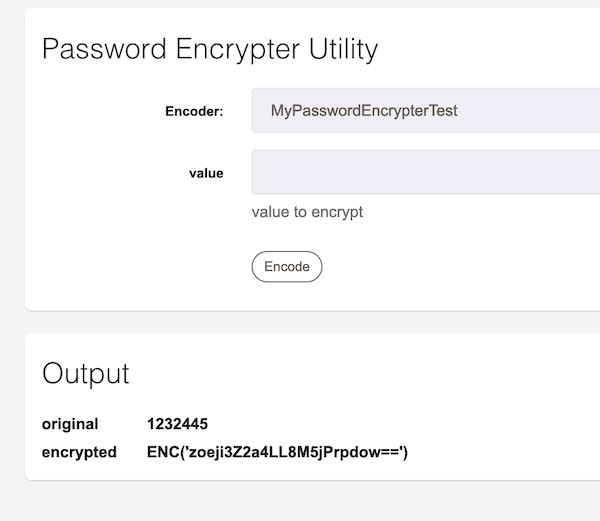# Password Encrypt Utility Plugins
# About
Password Utility Plugin allows you defined custom password encrypter through the Password Utility GUI. Then, using the GUI you will be able to encrypt password or text values with a custom encrypter that you determine.
# Use
Create a Password Utility Plugin and install it as a Rundeck Plugin.
You will need to implement the PasswordUtilityEncrypterPlugin interface.
Then, on the System > Password Utility menu option.
You will see your plugin on the available encoders list

Select your plugin and the plugin's attributes will be displayed on the form.

Finally, run the encryption

# Java Plugin Type
package com.plugin.example;
import com.dtolabs.rundeck.core.encrypter.EncryptorResponse;
import com.dtolabs.rundeck.core.encrypter.PasswordUtilityEncrypterPlugin;
import com.dtolabs.rundeck.core.plugins.Plugin;
import com.dtolabs.rundeck.core.plugins.configuration.*;
import com.dtolabs.rundeck.plugins.ServiceNameConstants;
import com.dtolabs.rundeck.plugins.descriptions.PluginDescription;
import com.dtolabs.rundeck.plugins.util.*;
import java.util.ArrayList;
import java.util.HashMap;
import java.util.Map;
@Plugin(service = ServiceNameConstants.PasswordUtilityEncrypter, name ="MyPasswordEncrypterTest")
@PluginDescription(title = "MyPasswordEncrypterTest", description = "MyPasswordEncrypterTest")
/**
* new MyPasswordEncrypterTest plugin, will provide the encrypt function on the rundeck GUI (Password Utility page)
*/
public class MyPasswordEncrypterTest implements PasswordUtilityEncrypterPlugin, Describable {
static Description DESCRIPTION = DescriptionBuilder.builder()
.name("MyPasswordEncrypterTest")
.title("MyPasswordEncrypterTest")
.description("MyPasswordEncrypterTest description")
.property(PropertyUtil.string("value", "value", "value to encrypt", true, null))
.build();
@Override
public Description getDescription() {
return DESCRIPTION;
}
/**
* will perform the encrypt process based on the parameters set on formProperties()
* The {@link config} map of parametes passing form gue GUI.
*/
@Override
public EncryptorResponse encrypt(Map config) {
EncryptorResponseImpl result = new EncryptorResponseImpl();
try {
//get the value set on the GUI form
String valToEncrypt = (String) config.get("value");
//my custom encripter (you will need to define your custom encryptor)
CustomEncryptor encryptor = ...
String encryptedValue = encryptor.encrypt(valToEncrypt);
result.setValid(true);
//this will be returned to the page, this map will be printed on the GUI
Map<String, String> outputs = new HashMap();
outputs.put("original", valToEncrypt);
outputs.put("encrypted", "encryptedValue");
result.setOuputs(outputs);
}catch (Exception e){
result.setValid(false);
result.setError(e.getMessage());
}
return result;
}
class EncryptorResponseImpl implements EncryptorResponse{
boolean isValid;
String error;
Map<String, String> ouputs;
public void setValid(boolean valid) {
isValid = valid;
}
public void setError(String error) {
this.error = error;
}
public void setOuputs(Map<String, String> ouputs) {
this.ouputs = ouputs;
}
@Override
public boolean isValid() {
return isValid;
}
@Override
public String getError() {
return error;
}
@Override
public Map<String, String> getOutputs() {
return ouputs;
}
}
}
Copied!